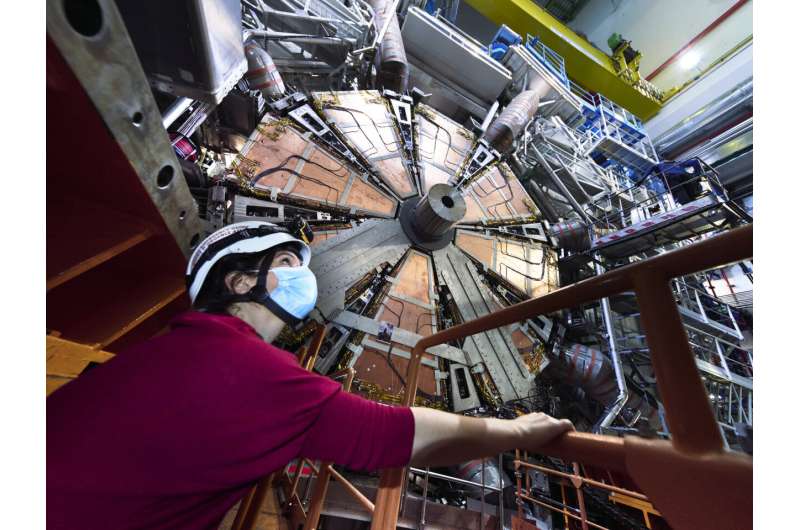Detectors for a new era of ATLAS physics

The High-Luminosity upgrade of the Large Hadron Collider (HL-LHC) will dramatically increase the rate of collisions in the ATLAS experiment. While offering an opportunity for physicists to explore some of the rarest processes in the universe, the large collision rate brings new challenges—in particular, higher radiation levels and significantly more data. The ATLAS collaboration is adapting to deal with these challenges by upgrading all parts of its detectors with new, state-of-the-art instruments.
"The Muon New Small Wheels (NSW) are the first new detectors in ATLAS specifically designed to handle high-luminosity conditions," says ATLAS Spokesperson Andreas Hoecker. "The installation of the second—and final—NSW follows nearly a decade of dedicated efforts by ATLAS members, who designed, constructed and assembled this high-tech muon detector from scratch."
Cutting-edge technology
The ATLAS NSW system is made up of two wheel-shaped detectors, sitting at opposite ends of the experimental cavern. Named in comparison to ATLAS's 25-meter "big wheel" detectors, each NSW weighs more than 100 tons and is nearly 10 meters in diameter.
More important than size is function. The NSW detectors are at the forefront of detector design, using two innovative gaseous detector technologies: micromegas (MM) and small-strip thin-gap chambers (sTGC). These provide both fast and precise muon-tracking capabilities. "The improved spatial resolution allowed by the NSW will be especially critical for the ATLAS "trigger," the system that decides which collision events to store and which to discard. The trigger will rely on the NSW's excellent resolution to confirm whether a particle originated from the interaction point, thus reducing our chances of saving data from unwanted background events," says Mario Antonelli, NSW Phase 1 Upgrade Project Leader.
The readout capabilities of the overall system are staggering: two million MM readout channels and 350,000 sTGC electronic readout channels. Each wheel has 16 sectors, each containing two layers of MM and sTGC chambers with four measurement planes apiece, providing the physicists with useful redundancy as they trace a muon's track through the detectors.
The dance of detectors
While 2021 has seen the NSW detectors journey underground, this was not their first time on the move. "The NSW effort was multinational, with members from across the global ATLAS collaboration contributing to construction and design," says Philipp Fleischmann, ATLAS Muon System Project Leader.
After the original wheels were officially retired, NSW "A" was driven from Building 191 to the ATLAS surface hall on 6 July and, six days later, lowered into the ATLAS cavern where it was moved into its final position between the calorimeter endcap cryostat and the endcap toroid magnets. This momentous occasion was repeated for the NSW "C" four months later, as it was lowered into the ATLAS cavern on 4 November.
"That the team managed to keep the project on track despite a global pandemic and the tragic loss of their project leader, Stephanie Zimmermann, is a testament to their incredible talent and dedication," says ATLAS Technical Coordinator Ludovico Pontecorvo.
New wheels in motion
The NSW detectors will be instrumental in Run 3 data taking, as a moderate increase in luminosity is already planned for the LHC. While waiting to see the wheels in action, the ATLAS collaboration turns its focus to the next major upgrades of the experiment. "The next long shutdown of the LHC (LS3, scheduled for 2025) will be the last before the HL-LHC begins operation," says Francesco Lanni, ATLAS Upgrade Coordinator. "We have a lot to accomplish in the intervening years, including the construction and assembly of an entire new inner tracking system. But with each new upgrade, we get one step closer to the next chapter of LHC physics and the exciting discoveries that may lay within."
Provided by CERN





















